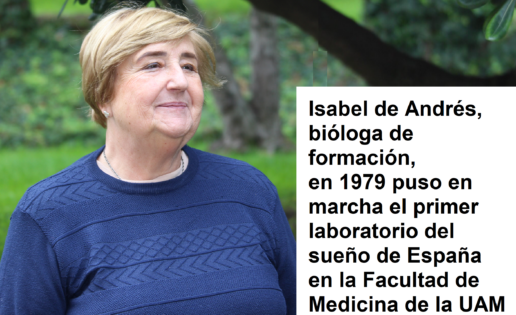



By Ruth Blanco GallegoStudent of the Master’s in Neuroscience at the UAM
Isabel de Andrés (Madrid, 1947) is Emeritus professor of Anatomy, Histology and Neuroscience at the Autonomous University of Madrid. More than 50 years dedicated to sleep research. He has participated in the establishment of the first experimental Sleep laboratory in Spain and in the discovery of the brain region linked to REM sleep. His contribution transcends the sphere of research, since She played a crucial role as secretary in the founding of the Spanish Society of Neuroscience and was a member of the first two boards of directors of this company, in addition to being Founding member of the Spanish Sleep Society.


Among his lines of research, it is worth highlighting the study of the anatomofunctional bases of the sleep-wake cycleand the study of the hypocretinergic system and its involvement in narcolepsy. Narcolepsy is a chronic neurological disease, characterized by hypersomnia and the intrusion of REM sleep features while awake, such as cataplexy attacks (sudden loss of muscle tone) and by the brain’s inability to regulate sleep and wake cycles. Today it affects more than 25,000 people in Spain, according to the Spanish Society of Neurology (SEN).
How could we define today what a dream is?
Sleep, occupying approximately a third of our lives, is essential for the quality of wakefulness. Unlike considering it a waste of time, its intrinsic importance is recognized. The interconnection between sleep and wakefulness is crucial in the life cycle, and Understanding the different stages of sleep is essential to improve the quality of wakefulness.
Isabel de Andrés has been part of the discovery of one of the regions that trigger REM sleep
Our laboratory joined, in the mid-80s, in a trend that arose through work done in J. Allan Hobson’s laboratory at Harvard[1]. They stimulated certain parts of the brain with cholinergic agents, such as the pons and brainstemand REM sleep was triggered. We tried to pinpoint which region of the pons and saw that the specific region to trigger REM sleep is the ventral part of the oral reticular nucleus of the pons.
[1]J. Allan Hobson is one of the most important researchers of the neural substrate of sleep. He became famous above all for two things: proposing (in 1975) the “activation synthesis model” and bitterly question the then dominant freudian theory of sleep -and, by extension, all of Freud’s work
Vogel in 1960 described as When sleeping, narcoleptic patients quickly entered REM sleep. Could you explain to us what narcolepsy is and its relationship with REM sleep?
Narcolepsy, a type of hypersomnia, is characterized by irregularity in the regulation of REM sleep during wakefulness. In narcolepsy type 1, individuals experience loss of muscle tone and cataplexy when faced with positive emotions, connecting the emotion to the transition to REM sleep. Even without cataplexy, there are attacks of REM sleep, jumping directly from wakefulness to REM in a pathological manner.
What is the role of the hypocretinergic system in narcolepsy?
It was an unexpected discovery. In 1998, hypocretins were studied, which were linked to intake. But there was a laboratory in which they administered these peptides to rats and at the same time video recordings were made. It was seen that while the rats were active, they would suddenly stop and fall, linking hypocretins to cataplexy. This discovery, associating orexins with cataplexy and narcolepsy, redefined their understanding and highlighted their importance in sleep disorders, marking a milestone in the research of narcolepsy and its relationship with orexins.
One of his latest investigations deals with this topic. Could you explain your discoveries in this regard?
Cataplexy, a distinctive symptom of narcolepsy, is the focus of our research. We have observed that hypocretin administration into the dorsal part of the pons increases wakefulness and reduces sleep, while microinjections into the ventral part cause a specific decrease in REM sleep. The application of orexin receptor antagonists shows effects on sleep, but the synergy between type 1 and type 2 receptors in the pons is key. We also studied the long-term impact with a chronic antagonist model, observing plasticity in orexin receptors and awaiting more detailed results.
What are the future challenges for sleep research?
In relation to sleep mechanisms, we have abundant information about different regions of the nervous system and how they influence the manifestations of REM and non-REM sleep. In terms of future challenges, it is crucial to understand how these structures interact, to facilitate smooth transitions. The study of narcolepsy becomes valuable to understand the failures in these transitions. Furthermore, biochemical studies are essential to understand the actions of compounds and substances on receptors. Sleep medicine has gained relevance, recognizing that sleep problems can negatively affect overall health..
Sleep medicine has gained relevance due to its importance for general health
Studying narcolepsy is essential to understand the transition between the different phases of sleep
What advice would you give to young researchers who are interested in the field of sleep physiology?
For young researchers in sleep physiology, I advise explore beyond your area, keeping ears open to diverse perspectives. Participate in scientific societies, even outside your specialty, broaden your horizons. Although you may enjoy specific meetings, it is crucial to have a broad view for the nervous system and be receptive to various influences.
Interviews